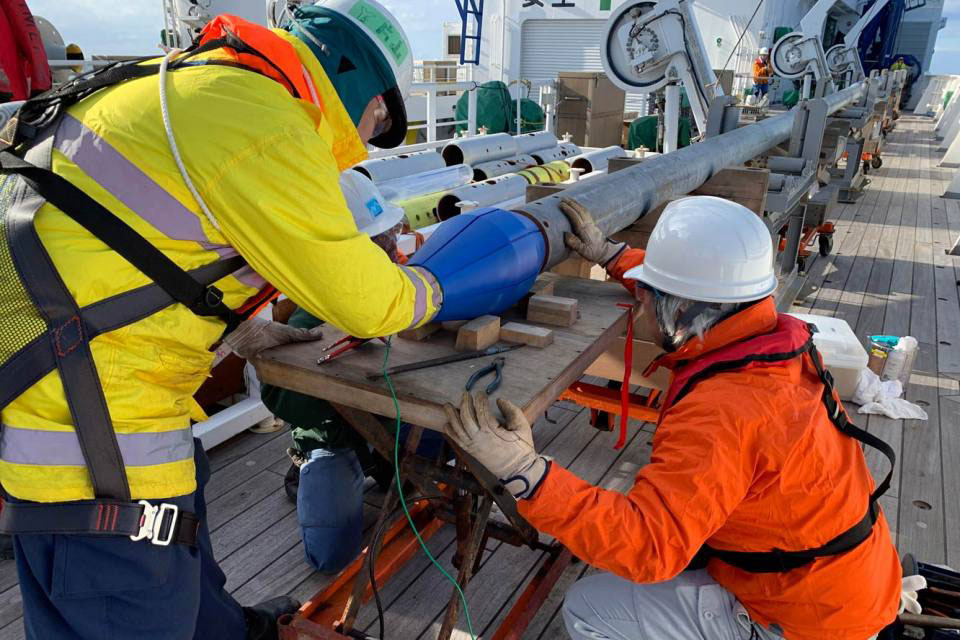The BGS Information Management (Geology) project populates and maintains a number of key geological databases and other information systems. This is done in collaboration with other teams within the survey that rely on well-managed and mature datasets to carry out their research and to create products, publications and services.
The project maintains the borehole geology database, which holds geological interpretations of boreholes drilled in Great Britain; it is one of our key data sets.
The borehole geology database is normally used in conjunction with another database, the Single Onshore Borehole Index, which is the index to borehole records that we hold.
The interpretations stored in the borehole geology database are made from borehole logs that show the geology encountered at depth within each borehole.
In many cases, these logs were created by the geotechnical companies responsible for drilling the holes and supplied to the BGS. In other cases, the logs may have been made by our own geologists, either at the time of drilling or subsequently from core samples, many of which are also held at the BGS.
The database is a primary source of data used to characterise the subsurface geology of Great Britain. It is heavily used for creating 3D models, including the National Geological Model.
The database holds more than three million records, relating to more than 600 000 boreholes. The data is stored in standardised, coded formats that ensure interoperability with our other data systems.
We have a continuous rolling programme of validation and verification, to make sure the data remains fit for use in producing our products and services.
We maintain a number of databases relating to economic minerals and construction materials of the UK, Europe and further afield.
BritPits: the mines and quarries database
BritPits, also known as the mines and quarries database, stores data describing both active and inactive onshore mineral workings, as well as rail depots and wharves involved in mineral commodities movement.
We populate and maintain the data, which is used periodically by our minerals team to produce the Directory of Mines and Quarries, which can be purchased from the BGS online bookshop or downloaded for free from the MineralsUK website.
The data is also used by the BGS and by our customers for market intelligence and analysis, and resource planning. The data may be licensed for use in developing value-added products.
UK and world mineral statistics database
The UK and world mineral statistics database contains detailed statistics on economic minerals production and trade.
We maintain this data; it is used by our minerals team for market intelligence and analysis.
The database is also used by our minerals team annually to produce publications such as World Mineral Production, European Mineral Statistics, and UK Minerals Yearbook. These publications provide reliable information to policymakers, regulators, industry and the public. They may be purchased from the BGS online bookshop or downloaded for free from the MineralsUK website.
Building stone database for Scotland
The building stone stone database for Scotland brings together data on the building stones of Scotland, their source quarries, and the samples and buildings that are associated with them.
The database development is funded jointly by the BGS and Historic Scotland; we assist in constructing, populating, and maintaining the database.
The NSD will be used to answer enquiries and support BGS projects; it will also be accessible to the public and should be of interest to a wide range of end users.
National stone database
The National Stone Database (NSD) is currently under construction and brings together data on the building stones of the UK, their source quarries, and the samples and buildings that are associated with them.
The database development has been supported and informed by the Strategic Stone Study (carried out in collaboration with English Heritage).
Further information about building stones, and a portal allowing search of data collected for the Strategic Stone Study, may be found on the MineralsUK website.
We host the National Archive of Geological Photographs, which includes pictures taken by the survey’s geoscientists as well as collections acquired from other organisations. There are many historical photographs and images of contemporary interest. The pictures can be searched and downloaded from Geoscenic.
National geotechnical properties database
We maintain the national geotechnical properties database, which primarily holds data and information from site investigations carried out for civil engineering purposes.
The information is supplied to us by clients, consultants and contractors either as paper records or as Association of Geotechnical and Geoenvironmental Specialists (AGS) digital data transfer format.
A small number of data points are from laboratory test results carried out by us.
Background
In the mid-1980s, data was stored in a series of flat file geotechnical datasets, generated for the applied geology mapping projects of urban areas. This was funded by the then Department of the Environment.
The data was inefficient to use and difficult to manage. A decision was made to create and populate a relational database and this is now the national database, with 54 data tables and 33 dictionary tables.
This information forms the basis for the geotechnical attributions of our 2D and 3D digital geological models; it underpins both our core and commissioned engineering geology research.
Database design
The design of the database is currently based on the AGS industry standard for electronic transfer of geotechnical and geoenvironmental data version 3.1.
It contains data relating to the project, the boreholes and pits within the report (including British National Grid Reference and geology), full descriptions, in situ measurements and results of tests on samples.
The distribution of data generally reflects the requirements of our projects, including UK rocks and soils lithostratigraphical studies, or the areas covered by ground information for sustainable development and geohazards projects.
Much of the data is from site investigations for major trunk road construction schemes and other major engineering projects. Data is added from paper records or AGS digital data transfer format, which is the preferred method as it can be added quickly and without transcription errors. Site investigations in AGS digital data transfer file format have greatly increased the coverage of the database.
Depositing data
In order to improve the national coverage of the database and its usefulness, the BGS would be very grateful to receive site investigation data in AGS file format. You can deposit your AGS data via the Data Deposit Portal.
We make extensive use of ‘controlled vocabularies’ to promote standardisation and interoperability between our databases and other information systems. We gather requirements and populate, promote and maintain key geological vocabularies, including those for rock and sediment types, and geological time.
BGS Rock Classification Scheme
The BGS Rock Classification Scheme (RCS) sets out a practical, logical and robust system for classifying and naming geological materials.
The RCS is described in a series of four free pdf reports authored by BGS geoscientists. It is also implemented as a database, which is used to constrain and standardise references to geological materials in our other databases and information systems.
- Search the RCS database
Other geoscience vocabularies
We maintain numerous controlled vocabularies in order to standardise terminology across our products and services.
These vocabularies cover subjects as diverse as:
- geological time
- published BGS geological maps
- lithological properties (e.g. grain size and shape; colour; hardness)
- sedimentary structures
- structural geology
- chemical elements
- types of laboratory analyses
Many of these vocabularies may be browsed online or may be accessed via a vocabulary web service.
The BGS Lexicon of Named Rock Units is a database of definitions of rock units and other geological deposits that we recognise in the UK and on its continental shelf.
As well as being a repository of knowledge, the BGS Lexicon is used to constrain the lithostratigraphical attribution of other BGS information systems. These include:
The BGS Lexicon holds approximately 19 500 records. A full lexicon entry includes details of the rock units:
- age
- geographical extent
- lithology
- lower and upper boundaries
- name and rank
- parent unit
- thickness
- type localities
The lexicon can be searched online and is regularly in the top ten most-viewed pages on the BGS website.
Enquiries about the BGS Lexicon of Named Rock Units should be made to Tim McCormick.
These reports are the result of cooperation between the BGS Stratigraphy Committee and the Geological Society Stratigraphy Commission, with the aim of reviewing the stratigraphical classification for all parts of Great Britain for which modern information is available. The reports are available for free download in pdf format.
Lithostratigraphic nomenclature of the UK North Sea
During the 1990s, we worked with the United Kingdom Offshore Operators Association (UKOOA, now Oil & Gas UK) to compile a revision of the existing UK North Sea lithostratigraphical nomenclature and to establish a new standard scheme.
Seven large format volumes were created, which are now available for free download in pdf format.
The geological timechart provides colourful reference material, for use in schools, colleges and the home, setting out the geological timescale and geochronological terms used by the BGS.
Need more information?
You may also be interested in

National Geoscience Data Centre
Collecting and preserving geoscientific data, making it available to a wide range of users and communities.

Marine geoscience data
The BGS manages marine geological and geophysical data from the seabed and sub-seabed mainly from the United Kingdom Continental Shelf (UKCS) and adjacent area including MEDIN, SEA and NHDA data.


